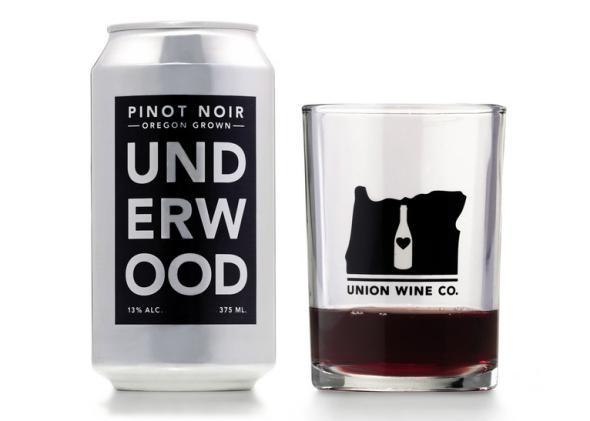On Wednesday night, I attended the New York launch party for Oregon winemaker Union Wine Company’s wine in a can. Their Underwood pinot gris and pinot noir—also sold in bottles—are now available in 375-milliliter cans (each of which translates to two generous glasses of wine). A canned rosé will follow in early 2015.
Union isn’t the first to sell wine in a can: Francis Coppola Winery sells hot pink mini cans of sparkling wine, complete with a straw, named after his daughter Sofia. Denver winery Infinite Monkey Theorem also sells four varieties of sparkling wine in cans. But unlike its predecessors, Union’s canned wine isn’t bubbly like beer or soda—it’s just traditional, uncarbonated red and white wine.
The existence of this product inspires two obvious questions: Why? And: How does it taste? I’ll answer the latter first: It tastes just fine. Poured into a glass, it tasted identical to the same wine poured out of a glass bottle. However, guzzling directly out of the can (if you’re feeling classy) doesn’t do the wine any favors: You do get a bit of a tinny taste, just as you do when drinking any other beverage from a can.
Back to question no. 1. I chatted with Union owner and winegrower Ryan Harms about what inspired wine in a can and how he envisions people drinking it. A condensed and edited version of our conversation follows.
Slate: I have to ask: Why are you producing wine in a can?
Ryan Harms: In wine, one of the barriers is this preconceived idea that you need knowledge to enjoy it. Our goal is to bring new consumers into the wine space. If the wine is in a can, you can’t get your nose in or swirl it, or be self-conscious about, “Am I doing it right?” You have to focus on what you’re doing at that moment.
A can also is about form and function. In Oregon, it’s hard not to be an outdoorsy person. Cans are portable, you’re able to handle and dispose of them easily.
Slate: What convinced you that now was the time to roll out this product?
Harms: It’s about the consumer. Listening to the consumer and the marketplace. It’s fun for us to do, but if people weren’t interested, we’d move on and just do bottles. At Portland Feast [in September 2013], the reaction was incredibly positive when we first presented the cans. People were excited. We had bottled wine and canned wine. People were fascinated. Given a choice, they wanted a can.
Other indicators are pointing to alternative packaging in wine, beer, and spirits, too. We felt like we were getting signals from the marketplace that it would be receptive.
Slate: What are the other alternate packaging options?
Harms: Bag-in-box is growing, Tetrapak for wine. There’s a wine company in California with bottles made of cardboard. Pouches. Single-serve and smaller servings are on the rise.
Slate: Why doesn’t the can affect the taste of the wine?
Harms: The liners we use these days are very sophisticated. Tinny or metallic flavors from cans, that’s a bygone era.
Slate: What are the liners made from?
Harms: It’s proprietary stuff. It’s a spray-on liner.
Slate: What has surprised you most about bringing this to market?
Harms: The support and encouragement we’ve received over the product. It’s a reminder that wine is first and foremost a beverage. There was a woman in her early 70s at Portland Feast, who tried the can and said to her friends, “I need this for the golf course!” It’s just about enjoying wine and sharing it with your friends.
